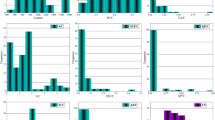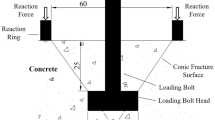Abstract
This study uses ANN-based lower upper bound estimation (LUBE) method for construction of prediction intervals (PIs) at different confidence levels (CL) for the compressive strength of concrete for the first time. For the purpose of this study, an experimental study is done to prepare the required database from different mix designs of concrete. The results of this study demonstrate efficiency of the LUBE method for the three CLs considered of 85%, 90% and 95% in which the values of prediction interval coverage probability (PICP) are all greater or equal than CLs, which indicates that the ANN-based LUBE method can produce PIs with a reliable coverage probability. In addition, with average interval width index of 34.0% and the average failure distance index of 3.7% for three confidence levels, LUBE represents a more reliable and informative than exact point predictions for the compressive strength data in the test data set.







Similar content being viewed by others
References
Akbari M, Afshar A (2014) Similarity-based error prediction approach for real-time inflow forecasting. Hydrol Res 45(4–5):589–602
Akbari M, Deligani VJ (2020) Data driven models for compressive strength prediction of concrete at high temperatures. Front Struct Civ Eng 14(2):311–321
Alshihri MM, Azmy AM, El-Bisy MS (2009) "Neural networks for predicting compressive strength of structural light weight concrete", Constr Build Mater. 23(6), 2214–2219, https://doi.org/10.1016/j.conbuildmat.2008.12.003.
Anctil F, Lauzon N (2004) Generalisation for neural networks through data sampling and training procedures, with applications to streamflow predictions. Hydrol Earth Sys Sci Discuss 8(5):940–958
ASTM C33 / C33M-16e1. (2016), Standard Specification for Concrete Aggregates, ASTM International, West Conshohocken, PA. London: British Standard Institution.
ASTM C39/C39M-10. (2010), Standard test method for compressive strength of cylindrical concrete specimens, ASTM International, West Conshohocken, PA.
Benoit DF, Van den Poel D (2009) Benefits of quantile regression for the analysis of customer lifetime value in a contractual setting: An application in financial services. Expert Syst Appl 36(7):10475–10484
Beycioğlu A, Gültekin A, Aruntaş HY, Gencel O, Dobiszewska M, Brostow W (2017) " Mechanical properties of blended cements at elevated temperatures predicted using a fuzzy logic model". Computers Concr. 20(2), 247–255, DOI: https://doi.org/10.12989/cac.2017.20.2.247.
Bilim C, Atiş CD, Tanyildizi H, Karahan O (2009) Predicting the compressive strength of ground granulated blast furnace slag concrete using artificial neural network. Adv Eng Softw 40(5):334–340. https://doi.org/10.1016/j.advengsoft.2008.05.005
BS EN 12390–3. (2009), Testing hardened concrete–Part 3: Compressive strength of test specimens,
Elder B, Arnold M, Murthi A, Navratil J (2020) "Learning prediction intervals for model performance". arXiv preprint https://arxiv.org/abs/2012.08625.
Kabir HD, Khosravi A, Hosen MA, Nahavandi S (2018a) Neural network-based uncertainty quantification: a survey of methodologies and applications. IEEE Access 6:36218–36234. https://doi.org/10.1109/ACCESS.2018.2836917
Kabir HD, Khosravi A, Hosen MA, Nahavandi S (2018b) "Partial Adversarial Training for Prediction Interval", 2018 International Joint Conference on Neural Networks (IJCNN), IEEE, 1–6, https://doi.org/10.1109/IJCNN.2018.8489153.
Kabir HD, Khosravi A, Kavousi-Fard A, Nahavandi S & Srinivasan D (2021) "Optimal uncertainty-guided neural network training". Appl Soft Comput. 99, 106878.
Kabir HD, Khosravi A, Nahavandi S, Srinivasan D (2020) "Neural network training for uncertainty quantification over time-range", IEEE Trans Emerg Top Comput Intell.
Kavousi-Fard A, Dabbaghjamanesh M, Jin T, Su W, Roustaei M (2020) "An evolutionary deep learning-based anomaly detection model for securing vehicles", IEEE Trans Intell Transp Syst.
Khademi F, Akbari M, Jamal SM (2016) Prediction of concrete compressive strength using ultrasonic pulse velocity test and artificial neural network modeling. Revista Romana De Materiale-Romanian J Mater 46(3):343–350
Khademi F, Akbari M, Jamal SM, Nikoo M (2017) Multiple linear regression, artificial neural network and fuzzy logic prediction of 28 days compressive strength of concrete. Front Struct Civ Eng 11(1):90–99. https://doi.org/10.1007/s11709-016-0363-9
Khosravi A, Mazloumi E, Nahavandi S, Creighton D, Van Lint JWC (2011a) Prediction intervals to account for uncertainties in travel time prediction. IEEE Trans Intell Transp Syst 12(2):537–547. https://doi.org/10.1109/TITS.2011.2106209
Khosravi A, Nahavandi S, Creighton D (2010a) A prediction interval-based approach to determine optimal structures of neural network metamodels. Expert Syst Appl 37(3):2377–2387. https://doi.org/10.1016/j.eswa.2009.07.059
Khosravi A, Nahavandi S, Creighton D (2010b) "Construction of optimal prediction intervals for load forecasting problems", IEEE Trans Power Sys. 25(3), 1496–1503, https://doi.org/10.1109/TPWRS.2010.2042309.
Khosravi A, Nahavandi S, Creighton D, Atiya AF (2011b) Lower upper bound estimation method for construction of neural network-based prediction intervals. IEEE Trans Neural Networks 22(3):337–346. https://doi.org/10.1109/TNN.2010.2096824
Kirkpatrick S, Gelatt CD, Vecchi MP (1983) "Optimization by simulated annealing", Sci 220(4598), 671–680, https://doi.org/10.1126/science.220.4598.671.
Koochali A, Dengel A, Ahmed S (2020) "If you like it, gan it. probabilistic multivariate times series forecast with gan", arXiv preprint https://arxiv.org/abs/2005.01181.
Marín LG, Valencia F, Sáez D (2016) “Prediction interval based on type-2 fuzzy systems for wind power generation and loads in microgrid control design”, In Fuzzy Systems (FUZZ-IEEE), 2016 IEEE International Conference. IEEE. https://doi.org/10.1109/FUZZ-IEEE.2016.7737705
Morala P, Cifuentes JA, Lillo RE, Ucar I (2021) "Towards a mathematical framework to inform neural network modelling via polynomial regression", Neural Netw.
Ni HG, Wang JZ (2000) Prediction of compressive strength of concrete by neural networks. Cem Concr Res 30(8):1245–1250. https://doi.org/10.1016/S0008-8846(00)00345-8
Özcan F, Atiş CD, Karahan O, Uncuoğlu E, Tanyildizi H (2009) Comparison of artificial neural network and fuzzy logic models for prediction of long-term compressive strength of silica fume concrete. Adv Eng Softw 40(9):856–863. https://doi.org/10.1016/j.advengsoft.2009.01.005
Öztaş A, Pala M, Özbay E, Kanca E, Caglar N, Bhatti MA (2006) Predicting the compressive strength and slump of high strength concrete using neural network. Constr Build Mater 20(9):769–775. https://doi.org/10.1016/j.conbuildmat.2005.01.054
Pierce SG, Worden K, Bezazi A (2008) Uncertainty analysis of a neural network used for fatigue lifetime prediction. Mech Syst Signal Process 22(6):1395–1411. https://doi.org/10.1016/j.ymssp.2007.12.004
Posch K, Juergen P (2020) "Correlated parameters to accurately measure uncertainty in deep neural networks", IEEE Trans Neural Netw Learn Sys.
Qazani MRC, Asadi H, Bellmann T, Perdrammehr S, Mohamed S, Nahavandi S (2020), "A new fuzzy logic based adaptive motion cueing algorithm using parallel simulation-based motion platform", In 2020 IEEE Inter Conference on Fuzzy Sys (FUZZ-IEEE) (pp. 1–8). IEEE.
Qazani MRC, Asadi H, Rostami M, Mohamed S, Lim CP, Nahavandi S (2021) "Adaptive motion cueing algorithm based on fuzzy logic using online dexterity and direction monitoring", IEEE Sys J.
Qu X, Ong YS, Gupta A (2021) "Frame-correlation transfers trigger economical attacks on deep reinforcement learning policies", IEEE Trans Cybern.
Quan H, Srinivasan D, Khosravi A (2014) Particle swarm optimization for construction of neural network-based prediction intervals. Neurocomputing 127:172–180. https://doi.org/10.1016/j.neucom.2013.08.020
Sadrmomtazi A, Sobhani J, Mirgozar MA (2013) Modeling compressive strength of EPS lightweight concrete using regression, neural network and ANFIS. Constr Build Mater 42:205–216. https://doi.org/10.1016/j.conbuildmat.2013.01.016
Shrestha DL, Solomatine DP (2006) Machine learning approaches for estimation of prediction interval for the model output. Neural Netw 19(2):225–235. https://doi.org/10.1016/j.neunet.2006.01.012
Sobhani J, Najimi M, Pourkhorshidi AR, Parhizkar T (2010) Prediction of the compressive strength of no-slump concrete: A comparative study of regression, neural network and ANFIS models. Constr Build Mater 24(5):709–718. https://doi.org/10.1016/j.conbuildmat.2009.10.037
Stojković M, Kostić S, Plavšić J, Prohaska S (2017) A joint stochastic-deterministic approach for long-term and short-term modelling of monthly flow rates. J Hydrol 544:555–566
Tanyildizi H (2009) Fuzzy logic model for the prediction of bond strength of high-strength lightweight concrete. Adv Eng Softw 40(3):161–169. https://doi.org/10.1016/j.advengsoft.2007.05.013
Taormina R, Chau KW (2015) ANN-based interval forecasting of streamflow discharges using the LUBE method and MOFIPS. Eng Appl Artif Intell 45:429–440. https://doi.org/10.1016/j.engappai.2015.07.019
Tsai HC, Liao MC (2019) "Knowledge-based learning for modeling concrete compressive strength using genetic programming", Computers Concr. 23(4), 255–265, https://doi.org/10.12989/cac.2019.23.4.255.
Tsivilis S, Parissakis G (1995) A mathematical model for the prediction of cement strength. Cem Concr Res 25(1):9–14. https://doi.org/10.1016/0008-8846(94)00106-9
Van Hinsbergen CI, Van Lint JWC, Van Zuylen HJ (2009) Bayesian committee of neural networks to predict travel times with confidence intervals. Transportation Research Part c: Emerging Technologies 17(5):498–509. https://doi.org/10.1016/j.trc.2009.04.007
Wan C, Xu Z, Pinson P (2013) Direct interval forecasting of wind power. IEEE Trans Power Syst 28(4):4877–4878. https://doi.org/10.1109/TPWRS.2013.2258824
Wolpert DH (1992) Stacked generalization. Neural Netw 5(2):241–259. https://doi.org/10.1016/S0893-6080(05)80023-1
Xue X, Zhou H (2018) "Neuro-fuzzy based approach for estimation of concrete compressive strength ", Computers Concr. 21(6), 697–703, https://doi.org/10.12989/cac.2018.21.6.697.
Zain MFM, Abd SM (2009) Multiple regression model for compressive strength prediction of high performance concrete. J Appl Sci 9(1):155–160
Zarandi MF, Türksen IB, Sobhani J, Ramezanianpour AA (2008) Fuzzy polynomial neural networks for approximation of the compressive strength of concrete. Appl Soft Comput 8(1):488–498. https://doi.org/10.1016/j.asoc.2007.02.010
Zhang C, Wei H, Xie L, Shen Y, Zhang K (2016) Direct interval forecasting of wind speed using radial basis function neural networks in a multi-objective optimization framework. Neurocomputing 205:53–63. https://doi.org/10.1016/j.neucom.2016.03.061
Zhang G, Wu Y, Wong KP, Xu Z, Dong ZY, Iu HHC (2015) An advanced approach for construction of optimal wind power prediction intervals. IEEE Trans Power Syst 30(5):2706–2715. https://doi.org/10.1109/TPWRS.2014.2363873
Zhao JH, Dong ZY, Xu Z, Wong KP (2008) A statistical approach for interval forecasting of the electricity price. IEEE Trans Power Syst 23(2):267–276. https://doi.org/10.1109/TPWRS.2008.919309
Author information
Authors and Affiliations
Corresponding author
Rights and permissions
About this article
Cite this article
Akbari, M., Kabir, H.M.D., Khosravi, A. et al. ANN-Based LUBE Model for Interval Prediction of Compressive Strength of Concrete. Iran J Sci Technol Trans Civ Eng 46, 1225–1235 (2022). https://doi.org/10.1007/s40996-021-00684-x
Received:
Accepted:
Published:
Issue Date:
DOI: https://doi.org/10.1007/s40996-021-00684-x




